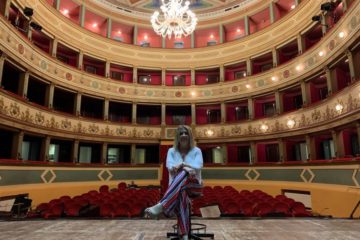Mark Campbell is one of today’s leading opera librettists. A champion of contemporary opera, Campbell has written 28 librettos, the most popular of which is Silent Night, which won the 2012 Pulitzer Prize in Music. The opera premiered at Minnesota Opera in 2011, and returns to the stage at the Ordway in St. Paul this season. I am thrilled to have had the opportunity to talk with Mark.

Silent Night
Photo by: Michal Daniel
I don’t know if there’s a “typical” or “standard” approach, but if there is or if you can generalize, what comes first – the words or music – when you begin to work on a project?
I’ve written 28 librettos and in every case, the libretto was written first. The composers with whom I collaborate always prefer to work that way because it gives them something tangible to compose with. I also structure my librettos to take full advantage of the opera form and create those moments that lead to arias, ensembles, etc.
What is the relationship like between composer and librettist? How do you work together in order to create something greater than the sum of its parts?
Every composer/librettist relationship is different and every new opera a composer/librettist works on is different. The trick is being adaptive (which is not the same as being slavish) to what the composer needs and to what the opera’s story demands. I will say that the most successful work I’ve created has been with composers who don’t think of themselves as librettists and who respect and understand the librettist’s craft. Paul Moravec, Kevin Puts, Julian Grant and Paola Prestini are just four examples of composers who know getting the best libretto from me means allowing me to do what I do.
Is it common for you to come up with the story that is to be set to music? What I mean is, do you come to the table with ideas for stories? Or does it usually work the other way; are you approached with stories that composers or opera companies want to set to music?
I’ve come up with stories (As One, Elizabeth Cree, The Manchurian Candidate, Later the Same Evening, Volpone, etc.), had composers suggest stories (Dinner At Eight, The (R)evolution of Steve Jobs, etc.) and had producers/artistic directors suggest stories (Silent Night, The Shining, The Nefarious, Immoral But Highly Profitable Enterprise of Mr. Burke & Mr. Hare, etc.).

Silent Night
Photo by: Michal Daniel
Minnesota Opera is performing Silent Night again this year; using that opera as an example, walk me through your creative process a bit. Where did the words come from?
Silent Night is an adaptation of the movie Joyeux Noël, screenplay by Christian Carion. The film is a genuinely moving experience, but I had to make MANY decisions to make it stage worthy and “sing.” As with all my projects, I began by studying the work or the subject and doing as much research as I could. I then absorb the story and begin looking at the material that is essential to the telling of it. At the same time, I often come up with a “theme sentence” to help guide me when I feel the story is getting unfocused. Then comes the outline. And another outline. And another … until the words begin writing themselves and I start writing through a character, not for a character.
Was there a section of Silent Night that was particularly challenging (or alternatively, rewarding) for you as a librettist?
The Silent Night libretto was relatively easy for me to write. The first act was done in about a week. The second act took longer because I had challenges establishing a climax (there really isn’t one in the movie). Once I created one—Sprink’s defection— the rest of Act Two fell into place pretty easily. I think the most rewarding moments in Silent Night for are the spaces I set up in the libretto for silence and sorrow. The architect Daniel Libeskind did something quite brilliant in his Jewish Museum in Berlin. He created a dark room several stories high with one small window that permits light where visitors to the museum can contemplate (or in my case weep) in solitude. Opera can do the same thing if the story is paced correctly and all of the collaborators trust earned silence.
You’ve got a long history with Minnesota Opera. What is it about the company or operation that has allowed for such a strong bond to grow?
Silent Night was my first opera and I’m now working on my 6th with the company: Edward Tulane. I think Minnesota Opera and I share a desire of wanting to tell stories that engage, rather than alienate audiences like so much contemporary opera does. Also, the whole workshop system Dale Johnson set up is a model for the industry to follow. It’s just a fantastic place to work and I’ll always be grateful to the company. I also have to give a shout out to director Eric Simonson who directed two of my most successful operas there: Silent Night and The Shining.
Tell us about Edward Tulane. What’s the story? Where did the idea come from?
Edward Tulane is a wonderful, much beloved, “young adult” novel by Kate DiCamillo called The Miraculous Journey of Edward Tulane. The basic story is about a stuffed rabbit looking for love, and it will be told with a lot of theatre magic and very moving music by Paola Prestini. Jamie Andrews, Chief Learning Officer, at Minnesota Opera, suggested it first and then Dale pushed it forward. We’re all excited about creating an opera for a multigenerational audience.
Do you write anything professionally besides opera librettos?
I’m working on the book of a musical for Théâtre du Châtelet and very excited about it. But other than that all the words I write are meant to be sung.
To finish, I’d like to ask a question I ask everyone: what is it about opera that touches your soul?
I love this question. Music and words can take people places words alone can never approach. When a story makes you care in opera, it really makes you care.


